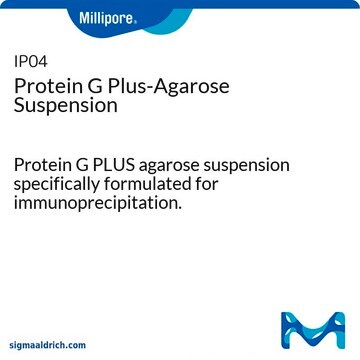おすすめの製品
ligand
recombinant protein G lacking albumin-binding region
包装
pack of 5 mL
メーカー/製品名
Cytiva 17-0618-01
保管条件
(20% Ehtanol)
Matrix
4% cross-linked agarose
平均直径
90 μm (d50v)
cleaning in place
2-10
動作範囲
3-9
適合性
suitable for bioprocess medium
保管温度
2-8°C
関連するカテゴリー
詳細
Protein G Sepharose™ 4 Fast Flow has recombinant protein G immobilized by the cyanogen bromide (CNBr) method to Sepharose™ 4 Fast Flow. Protein G exhibit binding specificities that complement Protein A media and binds to the Fc region of IgG from a variety of mammalian species. Protein G Sepharose™ 4 Fast Flow may be used to isolate and purify classes, subclasses and fragments of immunoglobulins from any biological fluid or cell culture medium.
As member of the BioProcess media range, Protein G Sepharose™ 4 Fast Flow meets industrial demands with security of supply and comprehensive technical and regulatory support.
特徴および利点
- Binding specificities that complement Protein A media.
- Binds a broad range of IgG species and subclasses.
- Multi-point attachment minimizes ligand leakage.
- Used in a range of research applications.
保管および安定性
アナリシスノート
法的情報
関連製品
シグナルワード
Warning
危険有害性情報
保管分類コード
3 - Flammable liquids
最新バージョンのいずれかを選択してください:
資料
This page shows a comparison of the relative binding strengths of protein G and protein A to different immunoglobulins.
This page shows how to perform a separation with the HiTrap Protein G HP from GE Healthcare, an Affinity Exclusion Chromatography product containing pre-packed Protein G.
This page shows how to perform a separation with the HiTrap Protein G HP from GE Healthcare, an Affinity Exclusion Chromatography product containing pre-packed Protein G.
This page describes immunoprecipitation (immunoaffinity or pull-down techniques).
プロトコル
This page provides information about different pull-down assays for the further isolation of multiprotein complexes to identify their components with products from GE Healthcare.
This page shows how to separate IgG antibodies by affinity chromatography using Protein G Sepharose 4 Fast Flow from GE Healthcare.
This page shows how to separate IgG antibodies by affinity chromatography using Protein G Sepharose 4 Fast Flow from GE Healthcare.
This page shows how to separate IgG antibodies by affinity chromatography using Protein G Sepharose 4 Fast Flow from GE Healthcare.
関連コンテンツ
Pull-down assays, reagents, and protocols for investigating in vitro protein-protein interactions using affinity or GST pull-down, tandem affinity purification (TAP), and co-immunoprecipitation methods.
アフィニティーまたはGSTプルダウン法、タンデムアフィニティー精製(TAP)法、共免疫沈降法を用いてin vitroのタンパク質間相互作用を検討するためのプルダウンアッセイ、試薬、プロトコル
ライフサイエンス、有機合成、材料科学、クロマトグラフィー、分析など、あらゆる分野の研究に経験のあるメンバーがおります。.
製品に関するお問い合わせはこちら(テクニカルサービス)









